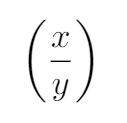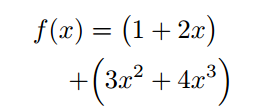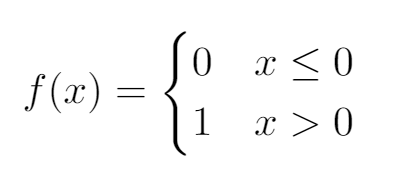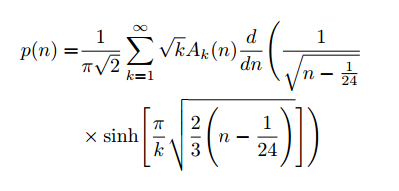Missing Inserted inserted Text to Be Read Again
This error appears when you have written a \left command, without a corresponding \right command. The \left and \correct commands are used for dynamically resizing parenthesis. The delimiters allowed which can be used with \left and \correct commands are () [] | \| \{ \} or the dot . . If you do not utilise the \left and \correct commands when placing parentheses effectually large items such every bit fractions and integrals, the parenthesis volition not be the aforementioned size as the expression independent:

You can identify fitted brackets around a fraction by writing \left( \frac{10}{y} \correct) . This will create nicer looking parenthesis which are the same size equally the expression independent within them:

If you lot write a \left command, but practise not finish the expression with a \right command, you lot volition generate the error shown below:
main.tex, line 5
<inserted text> \right . l.v \[ \left(10=\frac{ane}{2} \] I've inserted something that you may accept forgotten. (Encounter the <inserted text> to a higher place.) With luck, this volition get me unwedged. Only if y'all really didn't forget anything, try typing `2' now; then my insertion and my current dilemma will both disappear. [1
Common Causes
Forgetting to include a \right:
The most basic cause of this error occurs when you accept written a \left command merely have forgotten to include a respective \correct every bit shown beneath:
\[ \pi = \left( \int_{-\infty}^{+\infty} e^{-ten^2} dx ) \] 
This will generate an fault equally we have written a \left at the beginning of our expression, simply we take not written a \correct at the end of it. The correct way to write this expression is:
\[ \pi = \left( \int_{-\infty}^{+\infty} e^{-ten^ii} dx \correct) \] 
If you would like to only have a \left delimiter, with no \correct , you can solve this past including a \right. . The dot indicates that this \right volition exist blank.
Using \left and \right commands around alignment characters:
Some other common mistake is when \left and \right commands are used effectually alignment characters as shown beneath:
\begin{align} f(x) = \left( one &+ 2x \right)\\ + \left( 3x^2 &+ 4x^iii \right) \stop{align} This is not allowed, and will cause an mistake to be generated. The correct fashion to write this is to use \bigl and \bigr commands as shown below:
\brainstorm{align} f(x) = \bigl( i &+ 2x \bigr)\\ + \Bigl( 3x^2 &+ 4x^iii \Bigr) \end{align} 
These \bigl and \bigr commands are not dynamically fitted, and are a set size. The size volition need to exist chosen by hand, however they pose the reward of non needing to exist paired in the same way as \left and \correct commands. The choices of sizing -- in club of increasing size -- are \big , \Big , \bigg , and \Bigg . If you utilise these statements in pairs, such every bit \biggl[ and \biggr] , LaTeX will perform some syntax checking for you.
Using \left for piecewise functions:
A mutual cause of fault occurs when writing piecewise functions such equally the 1 shown below:

If yous write this as:
\[ f(x)= \left\{ \begin{array}{lr} 0 & x\leq 0 \\ ane & x > 0 \cease{array} /] yous volition generate an mistake, as at that place is no \right . One mode around this would be to include a blank \right by writing \right. as shown beneath:
\[ f(x)= \left\{ \begin{array}{lr} 0 & x\leq 0 \\ 1 & 10 > 0 \end{array} \right. /] A better way to write this is to avoid \left and \right commands entirely by using the cases enviromnent provided by the amsmath environment as shown below:
% In your preamble \usepackage{amsmath} % In the main body of your document \[ f(ten)= \begin{cases} 0 & 10\leq 0 \\ i & x > 0 \end{cases} /] Using line breaks inside \left and \correct commands:
When writing long expressions, you lot sometimes may desire to include line breaks as shown below:
The number of ways of writing a number $due north$ as a sum of positive integers is given by \begin{align*} p(n)= &\frac{1}{\pi \sqrt{2}} \sum_{grand=1}^\infty \sqrt{one thousand} A_k(n) \frac{d}{dn} \left({\frac {1} {\sqrt{n-\frac{1}{24}}} \\ &\times \sinh \left[ {\frac{\pi}{g} \sqrt{\frac{two}{3}\left(n-\frac{1}{24}\correct)}}\right] }\right) \end{align*} This will generate an error, equally we are not immune to include a line suspension \\ inside \left and \correct commands. The right way to write this expression is to over again apply \Biggl and \Biggr commands equally shown below:
The number of ways of writing a number $due north$ as a sum of positive integers is given past \begin{align*} p(due north)= &\frac{ane}{\pi \sqrt{2}} \sum_{k=1}^\infty \sqrt{k} A_k(n) \frac{d}{dn} \Biggl({\frac {1} {\sqrt{northward-\frac{1}{24}}} \\ &\times \sinh \Biggl[ {\frac{\pi}{thou} \sqrt{\frac{two}{3}\Biggl(north-\frac{1}{24}\Biggr)}}\Biggr] }\Biggr) \finish{align*} 
preslarappirdsmanne63.blogspot.com
Source: https://www.overleaf.com/learn/latex/Errors/Missing_%5Cright_inserted
0 Response to "Missing Inserted inserted Text to Be Read Again"
Postar um comentário